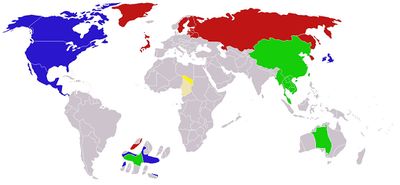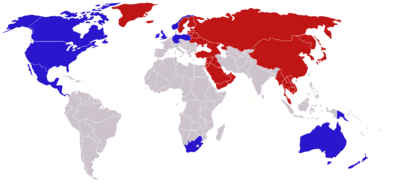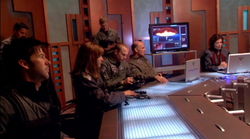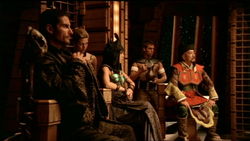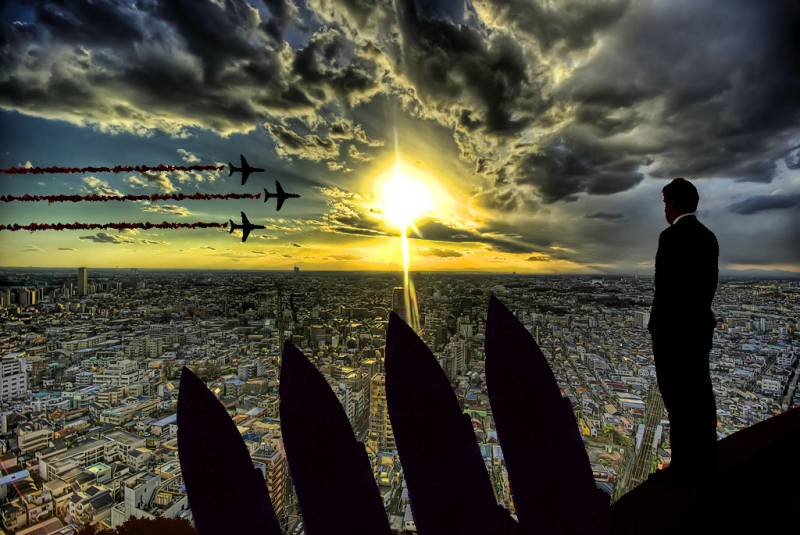User:Chili/Article about stuff
This page is a work in progress |
-Template taken from World War 3 and World War 4-
| Chili/Article about stuff | |||||
|---|---|---|---|---|---|
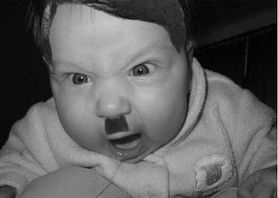
|
|||||
|
|||||
“War is a terrible thing, but is one of several problems that can be solved with a single roundhouse kick.”
– Chuck Norris on The Cyber Conflict
The Cyber Conflict is a pending military war, leading from the creation of the second Adolf Hitler, and hostile movements from The Allied Association (The AA). The first conflict begins in Switzerland with The AA becoming increasingly pissed off with their neutral stance towards the previous two major wars, World War 1 and World War 2.
The conflict splits the globe in to numerous hostile segregations, split up between The AA and the Democratic Party for the Modern Society of Never Never Land (DPMSNNL).
Background[edit | edit source]
Following World War III, the survivors, attempting to live with their lives without technologies they were used to, turn their lives around and return to the old ways from the 20th century. Although without technology, commercialization remains and large corporations, with large sums of money acquired from the government during the previous war, take over the lives of citizens to a far greater degree than in the 2000s.
This mass amount of commercialization leads to many rifts between people, notably with products such as Pepsi and RCoca-Cola (RC Cola buys out Coca-Cola in 2040). The most important of these conflicts involves North American beer drinkers and Russian Alliance vodka drinkers. Smirnoff intends to expand their operations by creating a brewery in coordination with Molson, while Molson wants to make beer in Russia. Consumers, extremely loyal due to the means of commercialization, take this minor dispute seriously, so seriously that it becomes an international issue.
American president Tyrone Al-Hussef V, extremely loyal to Canadian beer and commercialization, threatens the Russian Alliance for the attacks on Canadian and American soil, while Russian president Olga Lowina does the same. As threats continue, other countries begin to back America/Canada and Russia. When a bombing attempt on a Coors delivery truck occurs on June 17, 2047, Al-Hussef officially declares war on the Russian Alliance.
The War[edit | edit source]
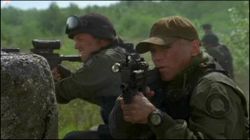
In 2047, Japanese sake supporters begin a full invasion of Capitalist China. The Russian Alliance, having supported the Japanese in 2040, are quick to lend support to their cause, entering the Japanese into the Russian Alliance. Battles in China last for some time due to the assistance of The Vietnam Protectorate and Communist China, with most of the conflicts ending in stalemates. However, Japanese troops are able to take over the Tsingtao Beer brewery, which controls a number of supply lines, weakening the Chinese forces and forcing their surrender in mid-2048.
The Western Russian Alliance efforts are hampered by Allied forces in Estonia, with numerous attacks on the highly commercialized state in the Alliance. This prompts a two-pronged war weakening the Russian Alliance's forces, almost resulting in the Allies cutting off Estonia from the Russian Alliance, until the Turkish Republic enters the Alliance (with an agreement for a supply of vodka factories in the republic), pushing the Allies out of Estonia. This new alliance is renamed the Siberian Alliance.
After the Allies are ousted out of Estonia, supply lines are restored to Siberian Alliance countries and they plan an all-out assault on major commercial establishments in North America to cripple their economy and to have the citizens lose support for their countries. With support from the Smirnoff Corporation, numerous Turkish Republic jet fighters are launched from Japan. Using radar-jamming technology, the Allies force the satellites of the Siberian Alliance to divert the jets to New Australia, a neutral country with both vodka and beer establishments. The jets bomb the vodka factories, which forces New Australia to act in kind, launching a huge unanticipated assault on Japan. New Australia officially declares themselves a member of the Allies.
It doesn't take the Siberian Alliance themselves to launch an attack on the Allied North America to start the conflict there. Mexican sympathizers to the Alliance set up an underground movement and attack the highly commercialized state of Nebraska, cutting off food supplies to many locations around the area. Canadian troops move in and are able to oust the Mexican Underground members, but this proves to be a distraction for an Alliance attack from the North Pole, commencing an invasion from the north.
By the start of September 2048, the Siberian Alliance forces and the Turkish Republic invade the Middle East Coalition, effectively taking control of many oil deposits. With oil cut off to the Allies, and the only supplies available left in Alberta, Canada, most Allied oil corporations fold, causing a fall in Allied morale. In mid-2049, all of Central America enters the Siberian Alliance after losing numerous battles, Hawaii is invaded, and the Canadians prevent an Alliance invasion from the north and west. The United Kingdom, a member of the Allies, is unable to assist due to numerous invasion attempts by Russia.
In space, the outdated International Space Station is fully taken control of by Allied forces in mid-2049, after a fight occurs on the station and Siberian Alliance members are ejected into space. With advances in laser technology, the Allies perform a last-ditch effort to install a laser weapon secretly on the station before the Alliance shoots the station down. A rocket is launched from outside Chicago with the appropriate technology and personnel. The installation of the weapon takes many other launches and many months, but is completed, despite numerous missile attacks by the Siberian Alliance outpost in Iceland. Once the weapon is completed, the laser weapon is fired on numerous commercialized locations in Europe, Asia and Central America. These efforts do not hinder the Alliance, as they break through the Canadian forces at the north and launch a successful attack on the rocket outpost in Chicago, ending any means of assistance to the ISS. By early 2051, the station's inhabitants run out of Pepsi Oxygen, effectively ending the threat from the station.

As the war goes on, commercialized companies, despite being targeted in attacks, continue to enhance means to achieve sales to offer even more money for the war. In early 2052, after many stalemated battles, the Middle East Coalition surprises the Alliance by turning on them, attacking numerous Asian facilities with their own technology and weaponry, after a secret deal with the Allies. The Allies are able to take the upper hand in the war, but stalemates are still common despite the oil industry booming again in North America. Due to the stalemates, negotiators with the Allies and Siberian Alliance try to formulate a peace treaty. When Pepsi and Smirnoff start making monetary deals to end the peace talks, the negotiators realise their countries are being fully controlled by commercialization. Allied President Al-Hussef and Alliance president Lowina agree to end the war, and, instead focus their efforts on lowering the power of large commercialized companies.
Even after the treaty is signed, numerous Allied military individuals, working with commercialized companies, launch attacks against Moscow, destroying numerous key governmental facilities and damaging the Smirnoff factory. Despite these actions, peace remains and those involved are charged with repairing the Chicago Launch Base, no longer sponsored by Subway.
The World[edit | edit source]
2047[edit | edit source]
In 2047, most of the countries in the world affected by commercialism are part of three factions, the Allies, the Russian Alliance or the Asian Alliance. A majority of battles in this year focus between Russia/Japan and the Asian Alliance, and numerous excursions between the Allies and Estonia. Smirnoff's numerous contributions to the Russian Alliance allow them to eventually gain the upper hand and force the Asian Alliance to merge with them.
Early 2048[edit | edit source]
In early 2048, a larger portion of the world get engulfed into the war, either due to invasions or corporate bribery. The Asian Alliance is deciminated by the Russians and Japanese and are made part of the Alliance with numerous vodka and Russian commercial centers setting up shop around their countries. The Turkish Republic join the Alliance to defend a satellite motor company in Estonia under attack by the Allies, forming the Siberian Alliance. Turkish attacks later lead to New Australia joining the Allies and the German Protectorate as well, after the Volkswagen motor headquarters are attacked.
Late 2048[edit | edit source]

By late 2048, most of the world has felt the effects of the war. The Siberian Alliance takes over the Middle East Coalition, cutting off oil supplies around the world and causing oil companies to cripple. This downfall would force other commercial companies to pick up the slack to keep the people's faith in commercialism alive. Norway, not declaring sides but offering facilities to prepare vodka, after being denied access to Siberian oil, turns the tides and joins the Allies, destroying the vodka facilities and opening up for Canadian beer. South Africa, after Norway's move, decides to join the Allies as well. Despite these additions to the Allies, the Siberians begin an invasion from the north of Canada and North America. A neo-fascist league in Brazil tears Brazil apart, later causing the beginning of World War V.
2049/2050[edit | edit source]
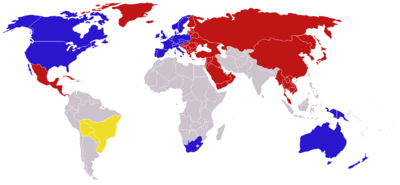

As the world becomes more involved in the war, more countries get involved. By late 2049, all of Europe has declared a side in the war, with about half of the countries joining the Allies and half being forced into the Alliance. Central America and Cuba declare themselves part of the Alliance and the northern islands of Canada are taken over as Canadian beer producers increase security around their plants. Norway, with a strong population fueled by commercialism, freed Sweden from the Alliance, marking the first country to be successfully freed from the Alliance. The Fascist League of South America grows, removing all commercialist influence from their society, resulting in the removal of many Alliance and Allied factories. Although this angers both sides, they focus on each other rather than the League. Iran engages in a full border closure and increases security. In a surprise move, they launch an experimental space fighter to destroy the International Space Station and its Pepsi Oxygen tanks, but don't declare themselves to be part of the Alliance. The mission fails.
Many stalemates and roadblocks to any form of progress occur after this point. Very few countries join either the Allies or Alliance and neither of them are able to make much ground on each other, apart from the Middle East Coalition joining the Allies.
Aftermath[edit | edit source]
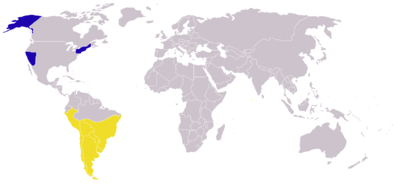
With the war finished in 2052, a new world economic order starts, with few commercialized states left. The states of California, Arizona, Alaska and the northeastern states can't give up their hold on commercialization, and thus, they are banished from the United States. Mexico joins the remaining USA, while the central states of Mexico return. China gains control of northeastern Alaska, with many people setting up 'ma-and-pa' operations in the cold north. The Russians there are removed, either returning to Russia or entering the Consumerized States of America. Iran, determining its experimental fighters work well on Earth, invade Iraq and Afghanistan, much to the chagrin of the USA who have had military operations there since 2003. Turkey divides part of it's territory, giving most of what it had back to European control. Due to military operations in Greenland, much of it has melted, causing northern Québec to flood.
Most notably, the Fascist League of South America, with the world focused on the War, are able to take over most of South America. Consumerized companies, before they are shut down, attempt to warn the world of this, but citizens, wary of commercialization, do not listen to them.
The Allies[edit | edit source]
Canada – One of the major suppliers of commercialized alcohol in the Allies and a major target by the Alliance and the Smirnoff corporation. Despite all the incursion by the Alliance on Canadian territory, they retain all their land at the end of the war, including control of the remainder of Greenland.
 United States of America, brought to you by Nike – Largely a commercialized state, with both citizens and government under the thumbs of conglomerates. A central target of the Alliance, they are continuously forced to rely on Canada for protection.
United States of America, brought to you by Nike – Largely a commercialized state, with both citizens and government under the thumbs of conglomerates. A central target of the Alliance, they are continuously forced to rely on Canada for protection. Tesco's United Kingdom – Being a large supporter of the United States, the British naturally come to their aid. They find themselves overwhelmed by the huge forces of the Chinese, but make it out of the war intact, despite losing the most people per square yard of land.
Tesco's United Kingdom – Being a large supporter of the United States, the British naturally come to their aid. They find themselves overwhelmed by the huge forces of the Chinese, but make it out of the war intact, despite losing the most people per square yard of land. Mexican Republic of Taco Bell – The last of the five major powers that be in the Allies, originally backed by strong monetary support from Taco Bell. When Mexican farmers refused to give their supplies to the company, Taco Bell forfeited their support, which turned the Mexicans over to the Alliance with support from Taco Bellski.
Mexican Republic of Taco Bell – The last of the five major powers that be in the Allies, originally backed by strong monetary support from Taco Bell. When Mexican farmers refused to give their supplies to the company, Taco Bell forfeited their support, which turned the Mexicans over to the Alliance with support from Taco Bellski.California Jr., brought to you by Fisher Price – The 52nd state of the United States, although considered a separate and primarily neutral country, supported the Allies in their war effort by producing many Ford and Dodge vehicles (both companies required several bailouts to keep going through all 4½ years of the war).
The Siberian Alliance[edit | edit source]
 The Motherland of Smirnoff Russia – Next to China, the powerhouse of the leftists Siberian Alliance. Strongly supported by the large Smirnoff Corporation, the citizens of Russia greatly support the military operations and prove to oppose the Allies.
The Motherland of Smirnoff Russia – Next to China, the powerhouse of the leftists Siberian Alliance. Strongly supported by the large Smirnoff Corporation, the citizens of Russia greatly support the military operations and prove to oppose the Allies. Hello Japan Kitty – Japan, being a major ally to Russia, even receiving some Russian territory after World War III, set up a number of Smirnoff factories around their country before the war. A major military force, it was the video game industry's major economic influence that help ensure quick victories with any battles.
Hello Japan Kitty – Japan, being a major ally to Russia, even receiving some Russian territory after World War III, set up a number of Smirnoff factories around their country before the war. A major military force, it was the video game industry's major economic influence that help ensure quick victories with any battles. Denny's Greenland – After World War III, Greenland became a territory of Russia, which becomes the major location for attacks on North America and vice versa. By the end of World War IV, much of Greenland is destroyed or melted.
Denny's Greenland – After World War III, Greenland became a territory of Russia, which becomes the major location for attacks on North America and vice versa. By the end of World War IV, much of Greenland is destroyed or melted.People's Capitalist Republic of China, brought to you by McDonald's – The head country for the Asian Alliance, after being taken over by the Russians and Smirnoff, is made part of the Siberian Alliance. The citizens' consumerist views changed, and they become a force to be reckoned with.
Aftermath[edit | edit source]
With the war over, and consumerism disappearing around the world, apart from the Consumerized States of America, the world enters into a new world economic order. Obesity declines and overall health improves, and the United States is removed from Iraq.
Everybody begins to rebuild from all the damage, but South America slowly sinks under the control of fascist leaders that rival Adolf Hitler for pure evil. Without a proper media or network of satellites (due to continuous missile attacks in the war) remaining, people are unaware of what the South Americans have planned...
| World Wars |
| I | II | III | IV | V | ∞ |
| World War Revolution | World War Collectors Boxset | The Video Game | The Sequel to the Video Game | The Board game | The Film | World War Craft |

